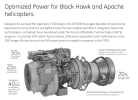I was browsing realcleardefense.com the other day and saw an ad for a new wonder engine that Pratt & Whitney and Honeywell are developing for the Army. Supposedly it's a drop-in replacement for the -64 and -60 and boasts 50% more power, 25% more fuel efficient and 20% longer engine life due to a new dual spool compressor design. The website was flashy but lacking substantive information.
-What makes this design so much better?
-What are the drawbacks?
-Is the Navy/USMC showing remote interest in this engine (MH-60S, H-1 series)?
-Is it even worth it since those aircraft were designed for a "weaker" engine?
-Thoughts?
http://www.dualspoolrules.com (catchy)
I'm suspicious, but open to be surprised in a good way
-What makes this design so much better?
-What are the drawbacks?
-Is the Navy/USMC showing remote interest in this engine (MH-60S, H-1 series)?
-Is it even worth it since those aircraft were designed for a "weaker" engine?
-Thoughts?
http://www.dualspoolrules.com (catchy)
I'm suspicious, but open to be surprised in a good way


 )
)